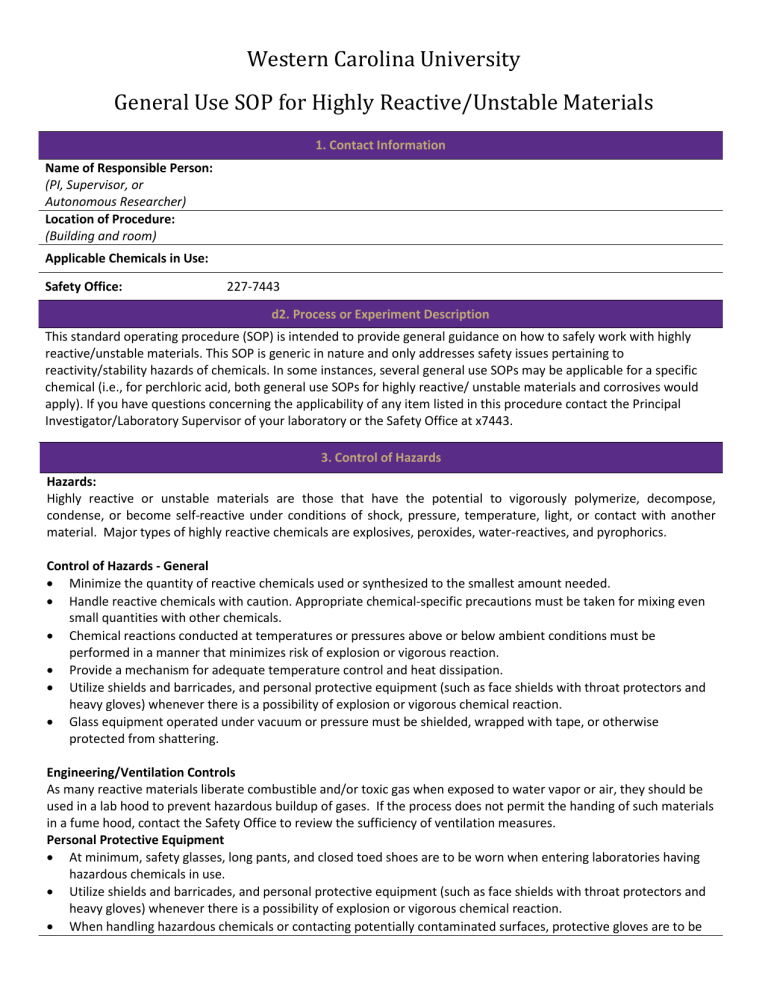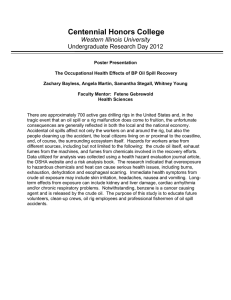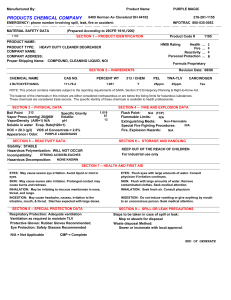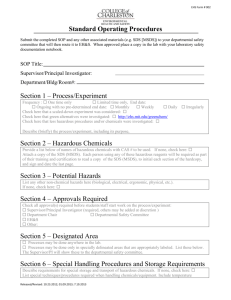Western Carolina University General Use SOP for Highly Reactive/Unstable Materials

Western Carolina University
General Use SOP for Highly Reactive/Unstable Materials
1. Contact Information
Name of Responsible Person:
(PI, Supervisor, or
Autonomous Researcher)
Location of Procedure:
(Building and room)
Applicable Chemicals in Use:
Safety Office: 227-7443 d2. Process or Experiment Description
This standard operating procedure (SOP) is intended to provide general guidance on how to safely work with highly reactive/unstable materials. This SOP is generic in nature and only addresses safety issues pertaining to reactivity/stability hazards of chemicals. In some instances, several general use SOPs may be applicable for a specific chemical (i.e., for perchloric acid, both general use SOPs for highly reactive/ unstable materials and corrosives would apply). If you have questions concerning the applicability of any item listed in this procedure contact the Principal
Investigator/Laboratory Supervisor of your laboratory or the Safety Office at x7443.
3. Control of Hazards
Hazards:
Highly reactive or unstable materials are those that have the potential to vigorously polymerize, decompose, condense, or become self-reactive under conditions of shock, pressure, temperature, light, or contact with another material. Major types of highly reactive chemicals are explosives, peroxides, water-reactives, and pyrophorics.
Control of Hazards - General
• Minimize the quantity of reactive chemicals used or synthesized to the smallest amount needed.
• Handle reactive chemicals with caution. Appropriate chemical-specific precautions must be taken for mixing even small quantities with other chemicals.
• Chemical reactions conducted at temperatures or pressures above or below ambient conditions must be performed in a manner that minimizes risk of explosion or vigorous reaction.
• Provide a mechanism for adequate temperature control and heat dissipation.
• Utilize shields and barricades, and personal protective equipment (such as face shields with throat protectors and heavy gloves) whenever there is a possibility of explosion or vigorous chemical reaction.
• Glass equipment operated under vacuum or pressure must be shielded, wrapped with tape, or otherwise protected from shattering.
Engineering/Ventilation Controls
As many reactive materials liberate combustible and/or toxic gas when exposed to water vapor or air, they should be used in a lab hood to prevent hazardous buildup of gases. If the process does not permit the handing of such materials in a fume hood, contact the Safety Office to review the sufficiency of ventilation measures.
Personal Protective Equipment
• At minimum, safety glasses, long pants, and closed toed shoes are to be worn when entering laboratories having hazardous chemicals in use.
• Utilize shields and barricades, and personal protective equipment (such as face shields with throat protectors and heavy gloves) whenever there is a possibility of explosion or vigorous chemical reaction.
• When handling hazardous chemicals or contacting potentially contaminated surfaces, protective gloves are to be
worn. For proper selection of glove material, review chemical SDS and glove manufacturing guidelines.
• Goggles (not safety glasses) are appropriate for processes where splash or spray is foreseeable.
• For hazardous chemicals that are toxic via skin contact/ absorption, additional protective clothing (i.e., faceshield, apron, over-sleeves) is appropriate where chemical contact with body/skin is foreseeable.
4. Special Handling Procedures and Storage Requirements.
Storage:
Ensure secondary containment and segregation of incompatible chemicals per guidance with the WCU CHP and any specific direction provided in SDS documentation.
Label all chemicals with date received and date opened. Unopened chemicals from the manufacturer should not be stored longer than 18 months. If an appropriate expiration date does not exist for opened containers, assign one as provided via the table below:
Classes of Chemicals That Can Form Peroxides Upon Aging
List A: Severe Peroxide Hazard on
Storage with Exposure to Air
List B: Peroxide Hazard on
Concentration; Do Not Distill or
Evaporate without First Testing For the Presence of Peroxides.
Discard within 3 months
List C: Hazard of Rapid Polymerization
Initiated by Intenally Formed
Peroxides.
•
•
•
Diisopropyl ether (isopropyl ether)
Divinylacetylene (DVA)
Potassium metal
• Potassium amide
• Sodium amide
• Vinylidene chloride (1,1dichloroethylene)
Discard or test for peroxides within 6 month
• Acetaldehyde diethyl acetal
• Cumene (Isopropylbenzene)
• Cyclohexene
• Cyclopentene
• Decalin (decahydronapthylene)
• Diacetylene (butadiene)
• Dicyclopentadiene
• Diethyl ether (ether)
• Diethylene glycol dimethyl ether
(diglyme)
• Dioxane
• Ethylene glycol dimethyl ether
(glyme)
• Ethylene glycol ether acetate
Normal liquids: Discard or test for peroxides after 6 Months
• Chloroprene (2-chloro-1,3butadiene)
• Styrene
• Vinyl acetate
• Vinylpyridine
•
•
•
•
Normal gases: Discard after 12 months
Butadiene
Tetrafluoroethylene (TFE)
Vinylacetylene (MVA)
Vinyl chloride
• Ethylene glycol monoethers
(cellusolves)
• Furan
• Methylacetylene
• Methylcyclopentane
• Methyl isobutyl ketone
• Tetrahydrofuran (THF)
• Tetralin (tetrahyronaphthalene)
• Vinyl ethers
This list should not be considered all-inclusive. Chemicals with similar names to the ones on this list should be given consideration when assessing the potential for peroxide formation. (reference : Prudent Practices for Disposal of
Chemicals from Laboratories)
Any chemicals with crystallization, visible discoloration, or liquid stratification may have potentially undergone peroxidation and must not be used or otherwise disturbed.
Handling:
Practice careful handling of materials that may be sensitive to shock, heat, friction, or light. After each use, carefully
wipe the container neck, cap and treads with a cloth before resealing. Never try to force open a stuck or rusted cap on a container of peroxide foring chemical.
5. Spill and Accident Procedures
The designation of a spill as a minor or major spill will depend upon the hazard of the chemical in question, as well as the risks involved within the laboratory environment. The quantities that justify considering a spill as a “major spill” will be left up to the discretion of the PI.
Minor Spills
1.
Notify fellow workers in vicinity of spill.
2.
Secure area, by restricting access and posting signs.
3.
Remove any potential ignition sources and unplug nearby electrical equipment.
4.
Gather chemical’s SDS for a hazard assessment and other pertinent information.
5.
Locate an appropriate Spill Kit, if available. Some corrosives can be neutralized prior to clean up.
6.
Don appropriate personal protective equipment (PPE) which usually includes chemical splash goggles, gloves, apron or lab coat. If high splash potential exists, also wear a face shield and protective clothing.
7.
Confine and contain spill. Cover spill with appropriate absorbent material and neutralizing agent (when applicable).
8.
Clean up spill using a scoop or other suitable item and place material in appropriate disposal container.
9.
Decontaminate spill surface with mild detergent and water, as appropriate. Carefully remove PPE, place nonreusable items in disposal container and thoroughly wash hands.
10.
Complete a hazardous waste label and affix label to container.
11.
Replenish spill kit.
Major Spills
1.
Notify and evacuate fellow workers to a safe area. Post signs. DO NOT ATTEMPT TO CLEAN A MAJOR SPILL!
2.
If spill poses a fire hazard, activate nearest fire alarm. Call University Police at x8911 and give details of spill including specific location, chemical, quantity, and if anyone is injured.
3.
In case of an injury or chemical contamination: a.
Wear PPE and move victim from spill area. b.
Locate nearest emergency safety shower or eyewash. Remove contaminated clothing and flush affected areas with copious amounts of water for 15 minutes. c.
If first aid trained, administer first aid as appropriate. Assist person to Employee Health or Emergency
Department (after hours) for treatment. If possible, bring chemical label or MSDS.
4.
University Police will contact the Safety Office and either Safety Office staff or outside personnel will respond to the spill.
5.
Staff knowledgeable about the spill should provide responders with all pertinent information and SDS.
6.
The responders or designee will inform staff when it is safe to re-enter spill area.
7.
Investigate cause of spill. Document spill, response and follow-up with staff and Safety Office.
6. Waste Disposal
Many reactive/unstable materials intended for disposal are likely to be considered hazardous wastes and should be disposed of accordingly. Consult WCU’s CHP for general guidance
7. Minimum Training Requirements
• Chemical Safety for Laboratories
• Laboratory-specific training
8. Approval Request
Reference the WCU CHP to determine the need for prior approval for high risk procedures. Approval must be granted from the PI and the Safety Office and documented in writing.
9. Decontamination Procedures
Personnel: If immediate medical attention is required, dial x8911 during normal business hours, or x9-911 outside of normal business hours. If contact occurs, remove any contaminated clothing, and IMMEDIATELY flush
contaminated skin with water for at least 15 minutes following any skin contact. For eye exposures,
IMMEDIATELY flush eyes with water for at least 15 minutes. Consult SDS for guidance on appropriate first aid.
Where medical attention is required, transport to University Health Services and make an effort to provide medical staff the SDS(s) of chemicals(s) to aid in proper diagnosis and treatment.
Area: Decontamination procedures vary depending on the material being handled. The toxicity of some materials can be neutralized with other reagents. All surfaces should be wiped with the appropriate cleaning agent following dispensing or handling. Waste materials generated should be treated as a hazardous waste.
10. Designated Area
For highly reactive/unstable materials that are also considered particularly hazardous substances, a designated area shall be established per other applicable SOPs.





